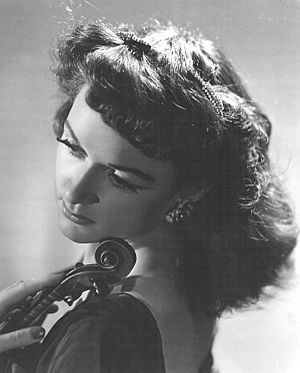Elisabeth Waldo facts for kids
Quick facts for kids
Elisabeth Waldo
|
|
|---|---|

Waldo c. 1950
|
|
| Background information | |
| Birth name | Elisabeth Ann Waldo |
| Born | June 18, 1918 Tacoma, Washington, U.S. |
| Occupation(s) |
|
| Instruments | Violin |
| Years active | 1940–2008 |
| Associated acts | |
Elisabeth Ann Waldo (born June 18, 1918) is an American musician. She is known as a violinist, composer, conductor, and someone who studies music from different cultures (an ethnomusicologist).
Contents
About Elisabeth Waldo
Her Early Life and Family
Elisabeth Ann Waldo was born on June 18, 1918, in Tacoma, Washington. Her mother, Jane Althea Blodgett, was a singer. Her father, Benjamin Franklin Waldo, was a relative of the famous writer Ralph Waldo Emerson. Elisabeth and her younger sister, Janet Waldo (who became an actress), grew up in Yakima.
In 1948, Elisabeth married Carl Schaefer Dentzel. They both loved Asian and Native American cultures and old objects. Carl was the director of the Southwest Museum in Los Angeles. Elisabeth and Carl had two sons, Dana and Paul.
Starting Her Music Journey
Elisabeth grew up on her family's ranch near the Yakama Indian Reservation in Washington state. She started singing when she was only three years old. By age five, she began playing the violin. A famous Russian violinist named Jascha Heifetz heard her play. He helped her get a scholarship to the Curtis Institute of Music in Philadelphia. This is where she received her music education.
In 1940, a conductor named Leopold Stokowski invited Elisabeth to join his new group, the All-American Youth Orchestra. They traveled around South America in 1940. Then, they toured North America in 1941. The orchestra stopped playing when the U.S. entered World War II. During these tours, Elisabeth became very interested in old musical instruments. She started collecting instruments from before Christopher Columbus arrived in the Americas.
After the orchestra, Elisabeth moved to Southern California. She played as a first violinist with the Los Angeles Philharmonic for one season. She then went back to Latin America as a solo performer. She played in many countries, including Panama, Costa Rica, Colombia, Peru, Chile, Cuba, and Mexico. She eventually lived in Mexico City. There, she was a regular musician on the national radio.
While in Mexico City, she often worked with the singer Agustín Lara. She also appeared as a violinist in the 1945 film Song of Mexico. This makes her one of the last living actors from the "Golden Age of Hollywood." She also became friends with the artist Diego Rivera. They both shared an interest in ancient and native music, especially from the Maya people. Rivera suggested that Elisabeth create her own way to write down music for pre-Columbian instruments. This would help her teach others how to play them.
From 1954 to 1955, Elisabeth played violin for the Peruvian-American singer Yma Sumac. Sumac's music mixed old Andean folk songs with Caribbean rhythms, big band jazz, and opera singing. Her shows were very popular in places like Hollywood and Las Vegas. Elisabeth saw her work with Sumac's touring show as part of her research into Latin American music.
Sumac worked with music arrangers like Les Baxter and Billy May. They helped create a style of music called "exotica." Elisabeth was inspired by her time with Sumac. She returned to Los Angeles and formed her own music group. This group used instruments from Native North, South, and Meso-America to play her own songs.
Recording and Later Career
Elisabeth Waldo was one of the first musicians to bring many ancient instruments into a recording studio. She used them for her albums like Maracatu (1959), Rites of the Pagan (1960), and Realm of the Incas (1961). These albums were based on her studies of native music. However, they were different from other recordings of Native American music at the time. Elisabeth's albums were made in a studio using the best recording technology. Also, all the songs were written by her. Because of this, her records were later called "new-age music" and then "exotica" instead of "world music."
Elisabeth was asked to write music for a play called People of the Book. This play was inspired by the Book of Mormon. It was performed at the Starlight Bowl in October 1967. The play was later performed again in Salt Lake City, Ogden, and Provo, Utah. Elisabeth's music received much praise. One newspaper said that "the sonic experience made one's attendance at this production worthwhile."
In the early 1970s, Elisabeth began writing music for film soundtracks. In the 1980s, she became interested in the music of China. She formed a group that helped introduce Chinese music and dance to schools in Los Angeles. This group toured China several times as part of a cultural exchange program. While there, Elisabeth performed her "Concierto Indo-Americano" with the Xian Symphony Orchestra. In 1987, she started the New Mission Theatre. This theater was a place for the Multi-Cultural Music and Art Foundation of Northridge to perform.
Her Music Albums
Albums
- Maracatu (Barbary Coast Records #33022, 1959)
- Rites of the Pagan (GNP Crescendo #601, 1960)
- Realm of the Incas (GNP Crescendo #603, 1961)
- People of the Book (Artisan Sound Recordings, 1967)
- Viva California with the St. Charles Choir (Peer Southern Organization #002, 1969)
- Sacred Rites (CD compiling tracks from her 1960 and 1961 LPs, GNP Crescendo #2225, 1994)
- Land of Golden Dreams (Southwinds Records #059, 2004)
- Heartstrings Soul of the Americas (CD Baby, 2008)
Singles
- "Making Chi-Cha"/"Balsa Boat" (GNP Crescendo, 1962)
Soundtracks
- Chac: Dios de la lluvia (1975)
- Lost on Paradise Island (1975)
See also
 In Spanish: Elisabeth Waldo para niños
In Spanish: Elisabeth Waldo para niños

